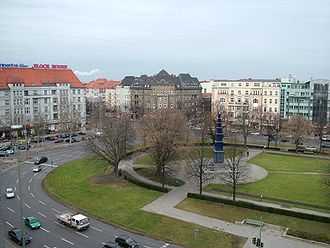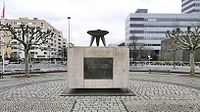Theodor-Heuss-Platz

The Theodor-Heuss-Platz (by residents simply called Theo) is a large city square in Berlin. It's located in the locality of Westend in the Charlottenburg-Wilmersdorf district. Following streets are leading into Theodor-Heuss-Platz:
- Heerstraße,
- Reichsstraße,
- Kaiserdamm,
- Lindenallee,
- Ahornallee,
- Pommernallee &
- Masurenallee
Underneath is the U-Bahn station Theodor-Heuss-Platz.
History


The square was constructed between 1904 and 1908 and was named Reichskanzlerplatz. At the beginning the square was still without houses.
On 21 April 1933 the square was renamed Adolf-Hitler-Platz. According to plans for the „Welthauptstadt Germania“ by Adolf Hitler and Albert Speer the square was to have an important role at the western end of the east-west axis. It was also planned to rename the square after Benito Mussolini as Mussoliniplatz. On 31 July 1947 the square's name returned to Reichskanzlerplatz.
Six days after the death of the first Federal President of Germany, Theodor Heuss on 18 December 1963, the square was given its present name.
In 2014, Google apologized after labeling Theodor-Heuss-Platz as Adolf-Hitler-Platz on its Google Maps service.[1]
Location
Via Kaiserdamm, Bismarckstraße and Straße des 17. Juni, the Theodor-Heuss-Platz is connected in a straight axis with Ernst-Reuter-Platz, the Berlin Victory Column, the Brandenburg Gate as well as Unter den Linden street and the Schloßplatz. The axis is continued in the west by the Heerstraße in a straight line until Scholzplatz.
Buildings


At the south of the square is the former Edinburgh House, the Deutschlandhaus and the Amerikahaus (clockwise). The at the beginning of the Heerstraße located Amerikahaus was known as the Summit House, Jerboa Cinema and Naafi centre until the British Forces left Berlin in 1994. Today it is used by the Cabaret Die Wühlmäuse. Since 1937 the studios of TV Station Paul Nipkow were located in the Deutschlandhaus. The Edinburgh House was a British Forces Hotel.
In 1970, the on the eastern edge of the square located 18-story high TV centre of the Sender Freies Berlin (SFB) was finished. After the merger with the ORB on 1 May 2003 it became home of the now created Rundfunk Berlin-Brandenburg (RBB). Close by in Masurenallee is the Haus des Rundfunks, finished 1930, which was seat of the east German Berliner Rundfunk before the founding of the SFB. It is located straight across the exhibition ground and the Funkturm.
Memorials and Art



On Theodor-Heuss-Platz burns the Eternal Flame as a memorial for the victims of flight and expulsion. It was erected in 1955.
The Bleu Obelisk was placed opposite the Eternal Flame in 1995.
In 1989 the sculpture duo Two Heads was erected at the eastern edge of the square, across Masurenallee.
References
- ↑ "Google apologizes for "Hitler" name on maps". CBS News. January 10, 2014. Retrieved 11 January 2014.
External links
![]() Media related to Theodor-Heuss-Platz (Berlin) at Wikimedia Commons
Media related to Theodor-Heuss-Platz (Berlin) at Wikimedia Commons
- Bezirkslexikon at berlin.de (German):
- BAOR Locations - Berlin various
- Berliner Untergrund.de about Theodor-Heuss Platz (german)
Coordinates: 52°30′34″N 13°16′22″E / 52.50944°N 13.27278°E